All Images


Press Release 08-013
The Pitter Patter of Little Feet . . . Climbing Straight Up a Wall

New adhesive is first to mimic quick catch and rapid release traits of a gecko's foot
Back to article | Note about images
 |
A gecko sits atop a glass surface in this image from the NIRT laboratory.
Credit: Kellar Autumn and Steve Scherf. Full resolution images are available for license, and require permission from Kellar Autumn for use (http://lclark.edu/~autumn). |
Download the high-resolution JPG version of the image. (92 KB)
|
Use your mouse to right-click (or Ctrl-click on a Mac) the link above and choose the option that will save the file or target to your computer.
|
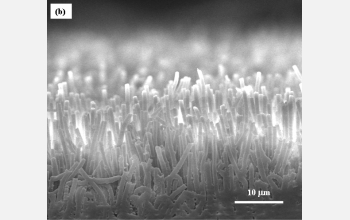 |
Researchers have developed a directional adhesive, inspired by the gecko, using microfibers made from a hard polymer, polypropylene. The polymer fibers are 600 nanometers in diameter, just 1/100 the diameter of a human hair, and are formed by a casting process. Like the gecko, the synthetic microfiber array is not sticky except when fibers slide a small distance along a surface. While the present microfiber array works on smooth glass, future versions could be useful for medical equipment, sporting goods, or climbing robots where a directional and easy attach-release adhesive is needed.
Credit: J. Lee and R.S. Fearing, UC Berkeley |
Download the high-resolution JPG version of the image. (96 KB)
|
Use your mouse to right-click (or Ctrl-click on a Mac) the link above and choose the option that will save the file or target to your computer.
|
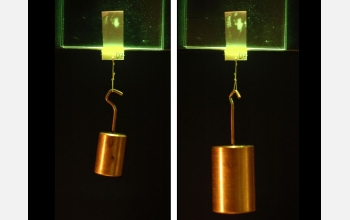 |
The gecko-inspired adhesive can support significant weight. Increasing weight increases contact area for the adhesive (contact area is the bright area near the top of the patch). As the load increases, more fibers are recruited to make contact, increasing the strength of the adhesion parallel to the surface. When the sliding force is removed, the fibers straighten, and the patch is easily released with negligible pull-off force. The patch has demonstrated better than 1/6 of a real gecko's stress on the same glass surface. A video showing the tape under testing in the laboratory is available at: http://robotics.eecs.berkeley.edu/~ronf/Gecko/Interface-slide-adhesion/SldingInducedAdhesion_spring_area.wmv
Credit: J. Lee and R.S. Fearing, UC Berkeley |
Download the high-resolution JPG version of the image. (43 KB)
|
Use your mouse to right-click (or Ctrl-click on a Mac) the link above and choose the option that will save the file or target to your computer.
|
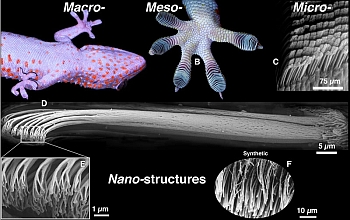 |
This collage illustrates gecko adhesion, from toes to nanostructures.
Credit: K. Autumn, Lewis and Clark College. Full resolution images are available for license, and require permission from Kellar Autumn for use (http://lclark.edu/~autumn). |
Download the high-resolution JPG version of the image. (91 KB)
|
Use your mouse to right-click (or Ctrl-click on a Mac) the link above and choose the option that will save the file or target to your computer.
|
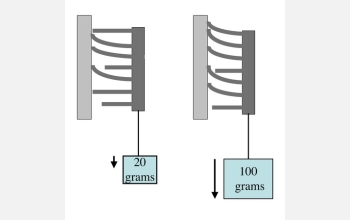 |
This conceptual drawing illustrates that as a load increases on the new adhesive material, more fibers are recruited to make contact, increasing the strength of adhesion parallel to the surface.
Credit: J. Lee and R.S. Fearing, UC Berkeley |
Download the high-resolution JPG version of the image. (22 KB)
|
Use your mouse to right-click (or Ctrl-click on a Mac) the link above and choose the option that will save the file or target to your computer.
|
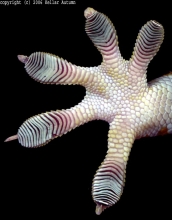 |
A close-up view of a tokay gecko's foot.
Credit: K. Autumn, Lewis and Clark College. Full resolution images are available for license, and require permission from Kellar Autumn for use (http://lclark.edu/~autumn). |
Download the high-resolution JPG version of the image. (80 KB)
|
Use your mouse to right-click (or Ctrl-click on a Mac) the link above and choose the option that will save the file or target to your computer.
|
|







